First things first: The answer to the mystery burrow. Several of you submitted guesses and except for our family clown – you know who you are – all guessed honey badger. That would be a very logical choice and one I might have even made had I not seen a warthog sitting in the entrance of the burrow when I approached. New mystery image at the end of this post.
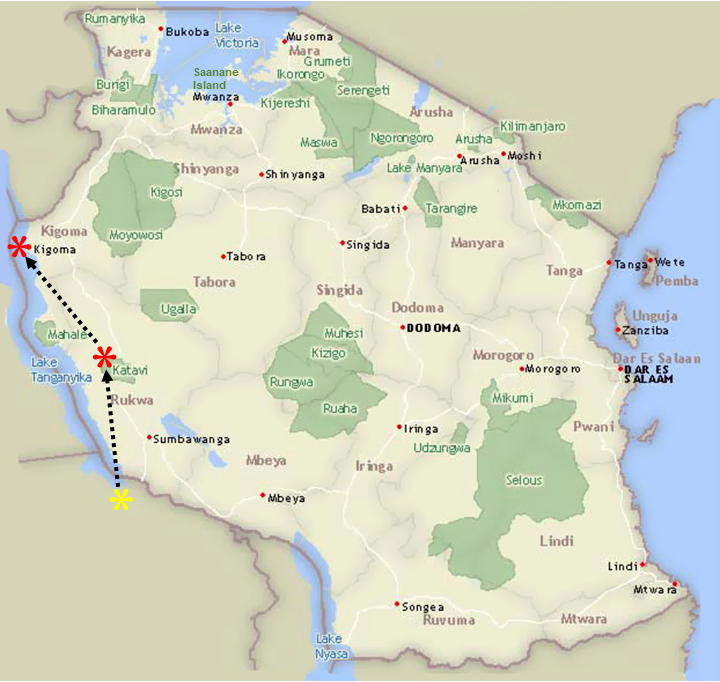
After leaving Katavi National Park, I headed north to the town of Kigoma on the shores of Lake Tanganyika and my jump off point for a boat ride to Gombe National Park and the site of Jane Goodall’s pioneering work on chimpanzees.
First, Lake Tanganyika is notable for being the second-oldest freshwater lake in the world, the second-largest by volume, and the second-deepest. It is also the world’s longest freshwater lake at 421 miles (and averaging 31 miles in width). The lake is shared among four countries—Tanzania, the Democratic Republic of the Congo (DRC), Burundi, and Zambia, with Tanzania (46%) and DRC (40%) possessing the majority of the lake. It drains into the Congo River system and ultimately into the Atlantic Ocean. And for you fish folk (i.e., Caitlin), this lake has at least 250 different species of cichlids – wow – and 98% are endemic (i.e., found nowhere else) – double wow! And there is a thriving fishery focused on the non-cichlid “tanganyika sardines”, which make up 25-40% of the protein in the local diet – wow again. Here’s a satellite view of this impressive lake that I borrowed from the internet:

My journey to “trek with the chimps” began in the town of Kigoma where I spent the night camping at Jacobsons Beach Lodge. Nothing too remarkable about this campsite except for the very tame zebra in my campsite that apparently escaped (and nobody cares) from an adjacent wildlife sanctuary. The site normally has a nice beach but apparently the lake level has risen in the past few years (presumably due to global warming?) and the beaches are now inundated, leaving a mostly rocky and rugged shoreline. Here are a couple of photos:
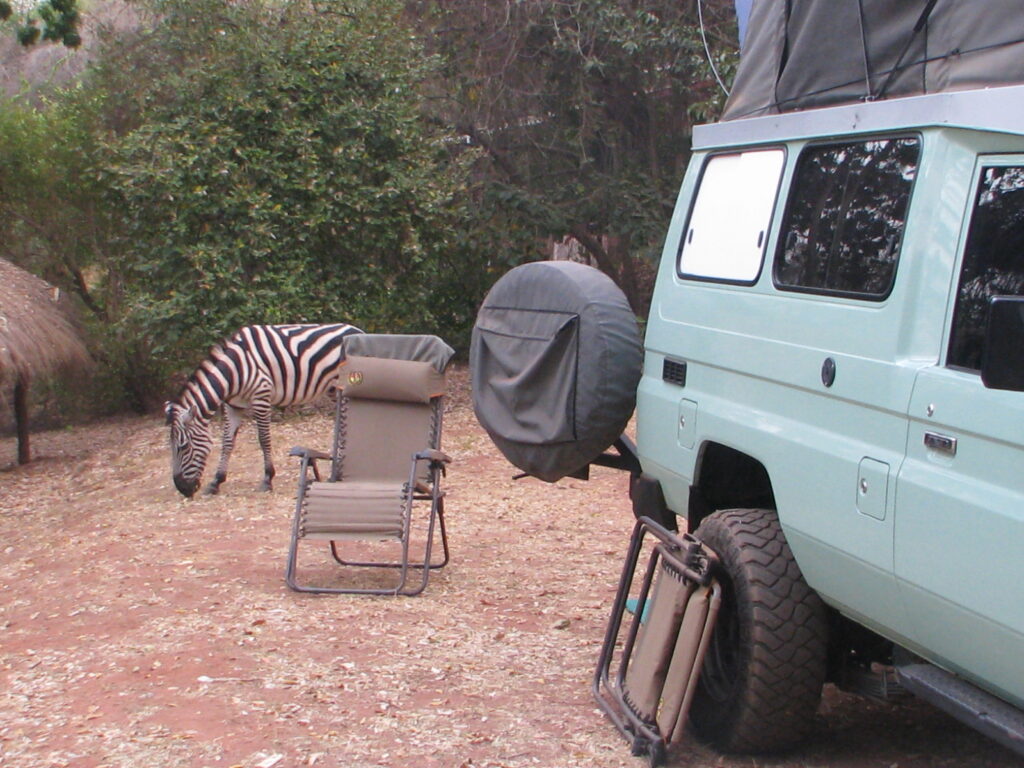
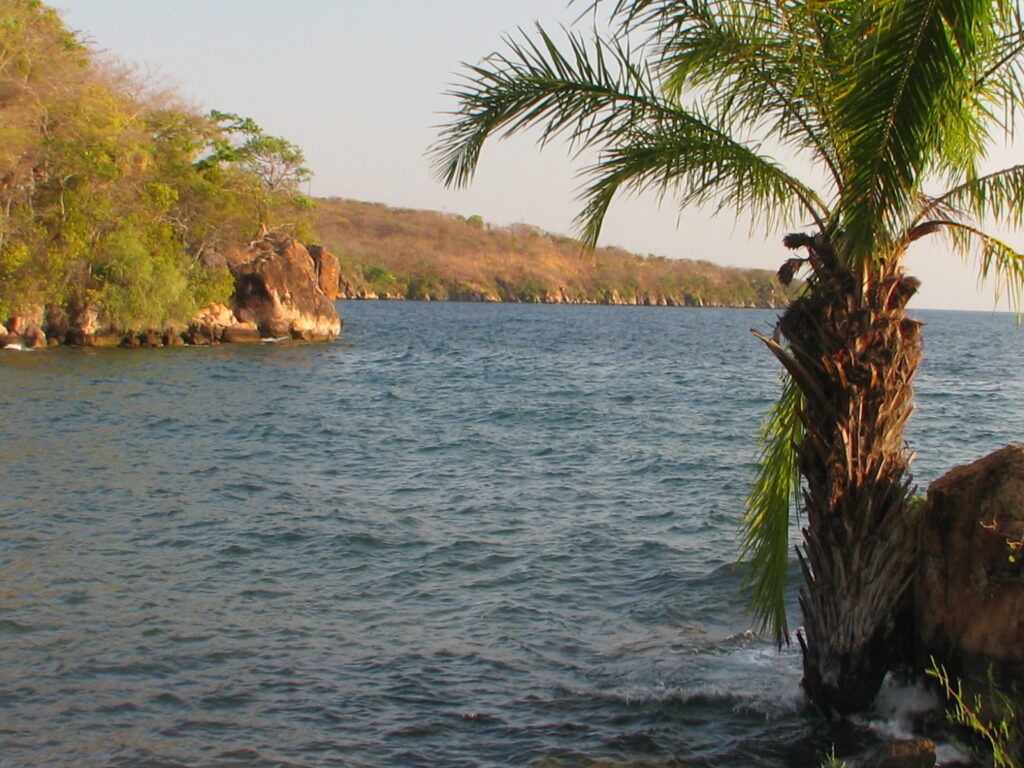
Oh, and did I mention that I met a really nice young Maasai man who hails from Lake Manyara region (folks from our Tanzania trip last year will remember this locale) but lives and works most of the time in Zanzibar running a small shop selling Maasai paraphernalia that he makes (mostly), but also serves as guide for an Italian couple (who he is with right now) that come back to Tanzania each year. His goal is to earn enough to return to his beloved homeland of Manyara. Here he is:
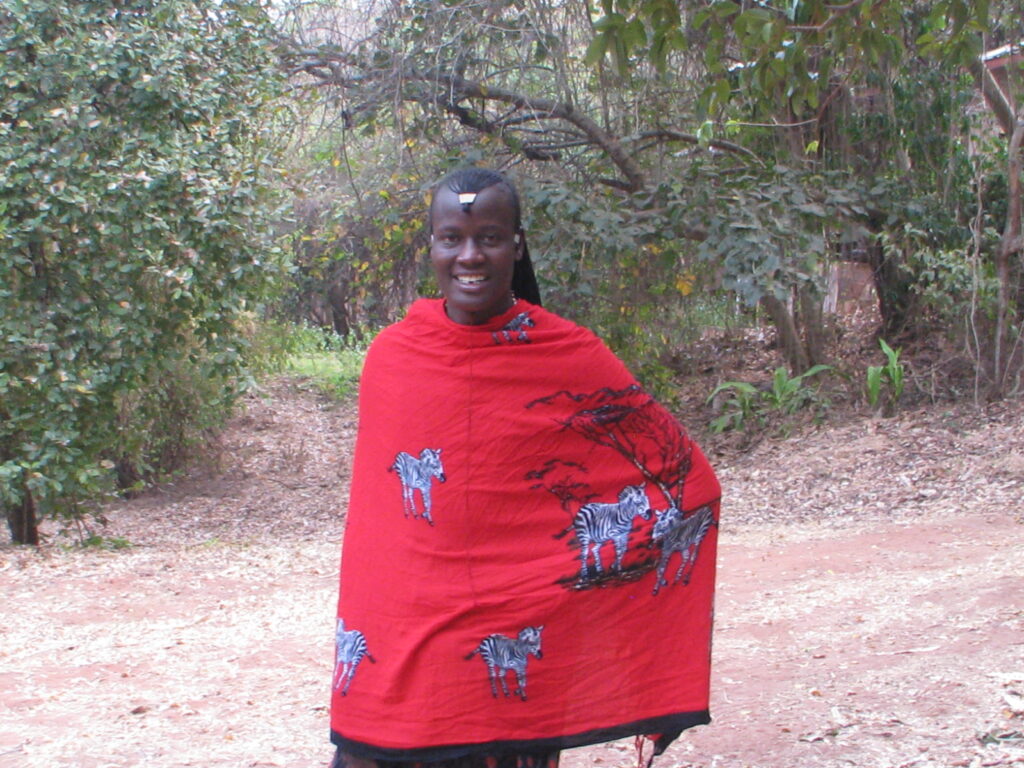
Kigoma was the jump-off port for a boat ride up the lake to the relatively small, but incredibly important, Gombe National Park and Jane Goodall’s chimps. The journey started with an attempt to get to the boat launch for the Park on the crowded portside streets. Turns out the street to the launch was blocked due to a washed out culvert that was under repair and the only other way to get there was on a side road that had a heavy hauler broken down in the one and only critical turn, making that route impassable. Did I ever meantion TIA before! Well, this was another classic TIA (This is Africa, in case you forgot). Fortunately, I was following a guide with a very nice German family that I met via the Parks office so I was not in charge of navigation – if I was, I would have never gotten there. To make a long story short, after much pondering and discussions with many street people offering advice, we inched our way through a small market lane not meant for landcruisers and then along the side of a drainage ditch not meant for vehicles at all that gave about 2 inches of space between the vehicle and either the metal sign post on one side and the 5-foot drop into the ditch on the other side. Well, we made it of course, and started our 1.5 hour boat ride up the lake to the Park. Here are a few photos of this auspicious start:
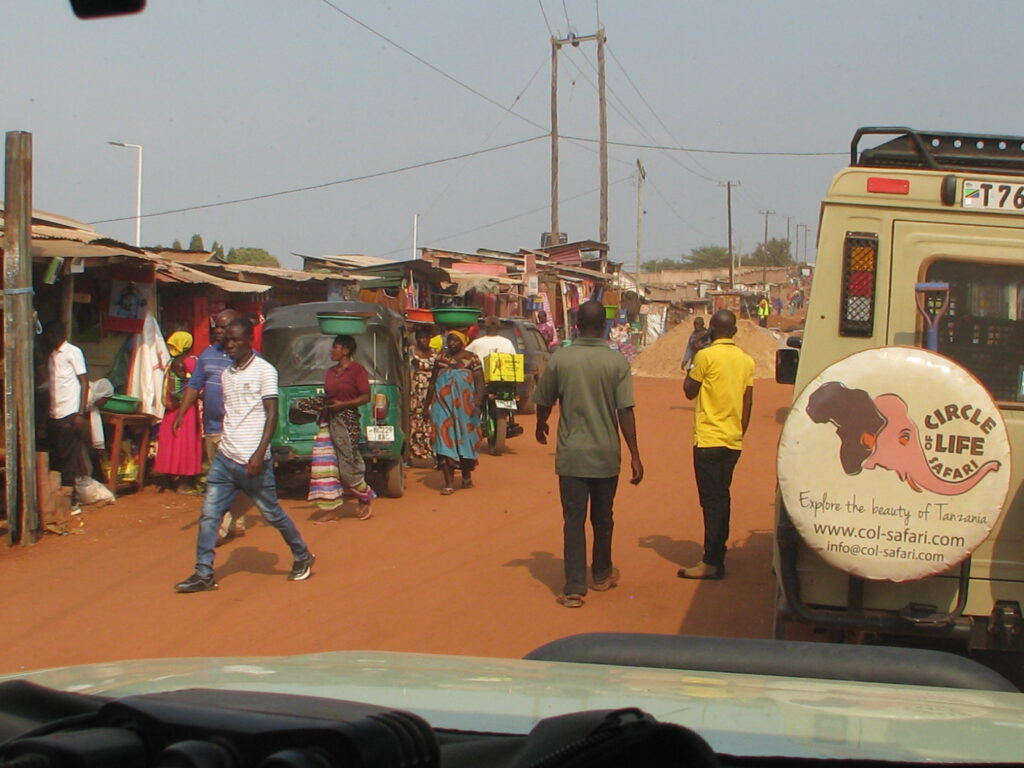
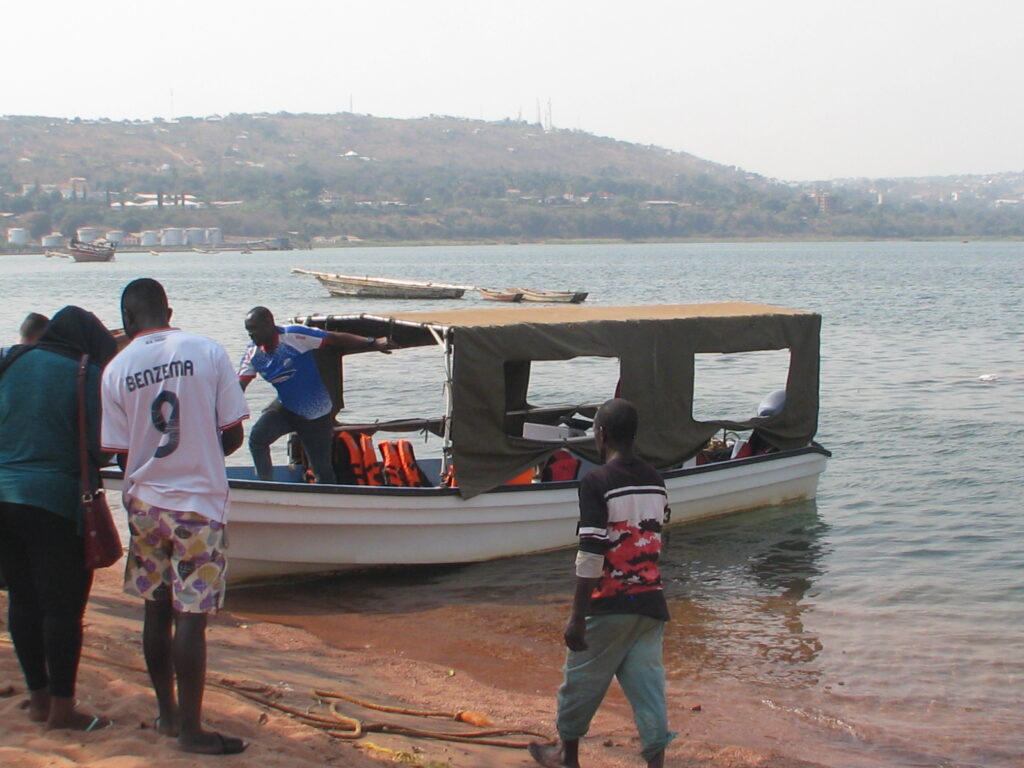

My destination of course was Gombe National Park, established in 1968 and one of the smallest parks in Tanzania at 13.5 square miles. This park is where Jane Goodall did her pioneering research on chimps for 60 years begining in 1960. Her work helped awaken the world to the plight of chimps and to their incredible social structure and human-like behavior. Chimp populations have declined dramatically over the past century from over 2 million to around 200,000, mainly due to habitat loss and fragmentation, poaching for the meat market (yes, native Africans eath chimps and other monkeys if given the opportunity), and the live animal (pet) trade (yes, people still think they can raise a chimp to be a household pet). Gombe used to be part of an extensive and contiuous forested habitat for chimps that extended the length of Lake Tanganyika and connected Gombe with the extensive Congo basin. Today, the only habitat remaining in Tanzania is in Gombe and her big sister Park, Mahale, located some distance down the lake. But Gombe is essentially an isolated island population now and likely to remain so. Fortunately, the 100 or so chimps in Gombe have maintained a relatively stable population for the past few decades since their isolation, but genetics over the long term could be the cause of their ultimate demise – only time will tell.
Here is the Gombe rest house (where I stayed) and adjacent research offices:
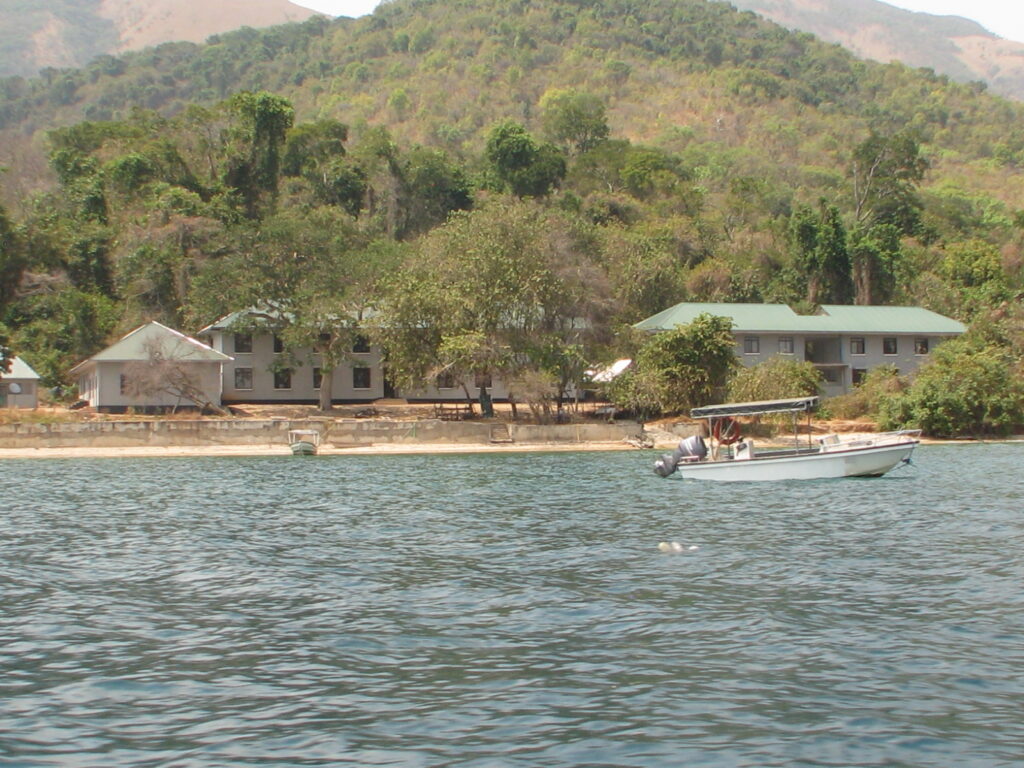
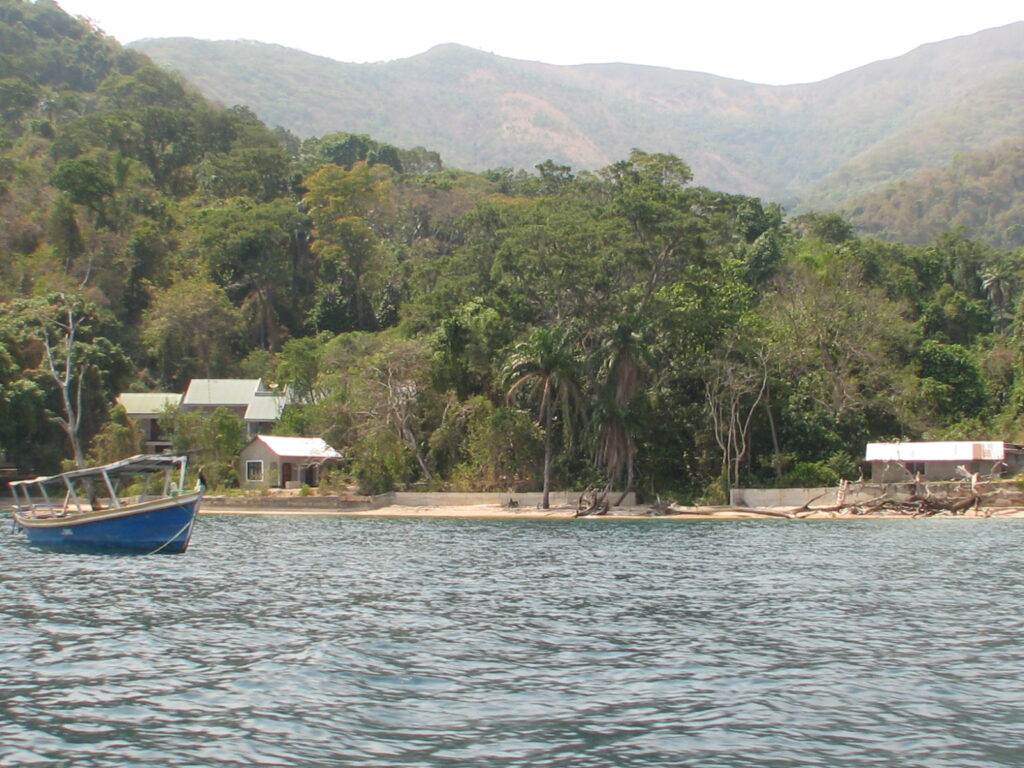
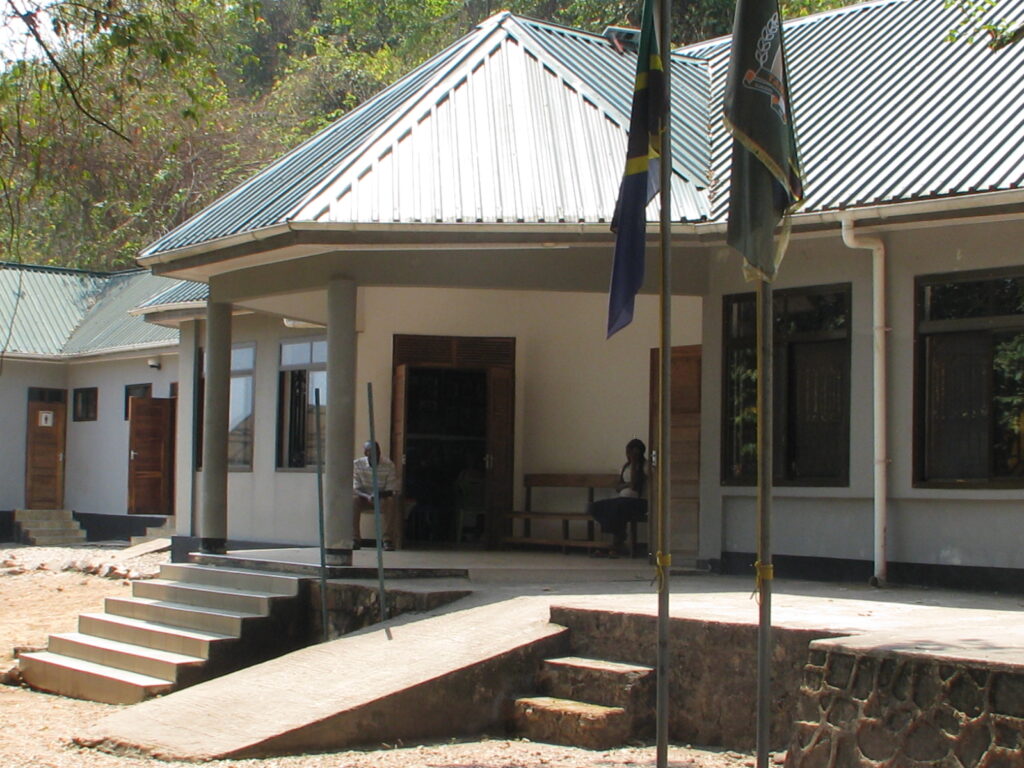

There is a rather large primate research station here at Gombe, including some 50-60 folks studying/monitoring chimps and another 20-30 studying/monitoring olive baboons and the red colobus and blue monkeys. It appears that is being run under the auspices of the Jane Goodall Institute and funded primarily by the US National Science Foundation. It turns out that I just missed meeting Jane Goodall herself by 2 days – bummer! Apparently, even at the age of 89 she still manages to come to Gombe for at least a week each year to check up on the chimp research. After considerable discussion with a couple of research assistants in the field, I must report that from what I understand the large team of researchers aren’t really doing much actual science anymore. The teams of assistants are simply watching the chimps and recording their behavior, for example, what they eat, how often and for how long, how much they play, clean each other, etc.. But they didn’t seem to know the overall purpose or objective of the behavioral observations. In otherwords, I gather there isn’t a big research question being addressed, but rather just behavioral monitoring. That’s OK, in part because it is employing a lot of people and maintaining enthusiasm for the Gombe chimps, but I don’t think they are trying to answer any big questions.
Our chimp trek on my first afternoon was unsuccessful as the chimps were not to be found nearby. However, on the morning of day 2, our trek took us into the hills of Gombe to cross paths with a small family of chimps. In the first half of the video below, you will meet Tanga, a 33 year old female, her 6.5 year old daughter Turwa, and her 2 year old son Temeke. We begin with them foraging on fruits in the tree canopy (at this point there are just a few of us with the chimps), then follow them overland to another foraging stop where they again go into the canopy (at this point we are joined by 3 other parties so our numbers baloon to like 25 – yuk!), and then follow them until they stop on a trail for some grooming. Temeke is quite a little character and loves to play and do somersaults and mess with his big sister. On the morning of day 3, our trek took us on an adventurous climb halfway up the mountain and several kilometers from camp, partly on human trails and partly on chimp trails requiring a fair amount of hands and knees to get through the tangle vines. In the second half of the video you will join Hippo and her offspring and her sister and her offspring as they trek along the trails for quite some time, eventually, thank goodness, stopping a couple of times on the trail so that we could catch our breadth and watch them. At the end along the creek they meet up with the alpha male of the entire community of about 60 chimps. His name is Fudge. Hope you enjoy watching this and although the video quality sucks at times and it doesn’t give you the full sensory experience, hopefully it will give you a partial experience a chimp trek.
Gombe Chimps video (21 minutes)
OK, I am off north to the shores of Lake Victoria, although it will take me a couple of days to get there. See you there.
Mystery image:
OK, for you people that like quizes and games, here’s another mystery organism picture for you to ponder. What kind of species made this structure? Answer come with next post:
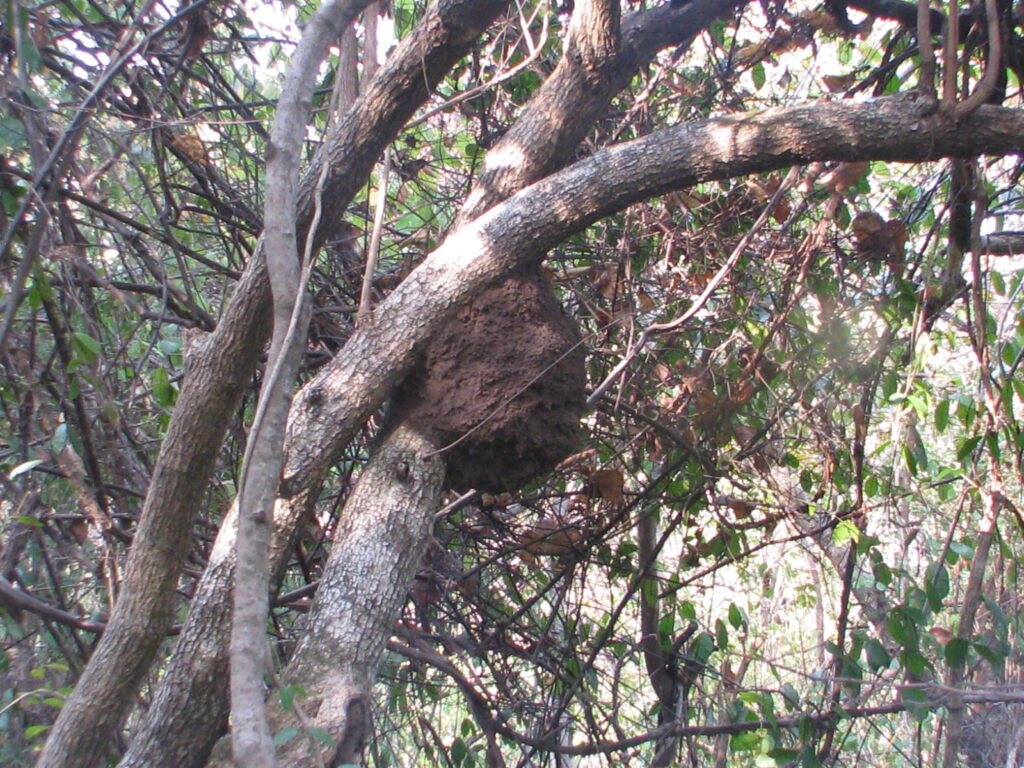
Photo Gallery:
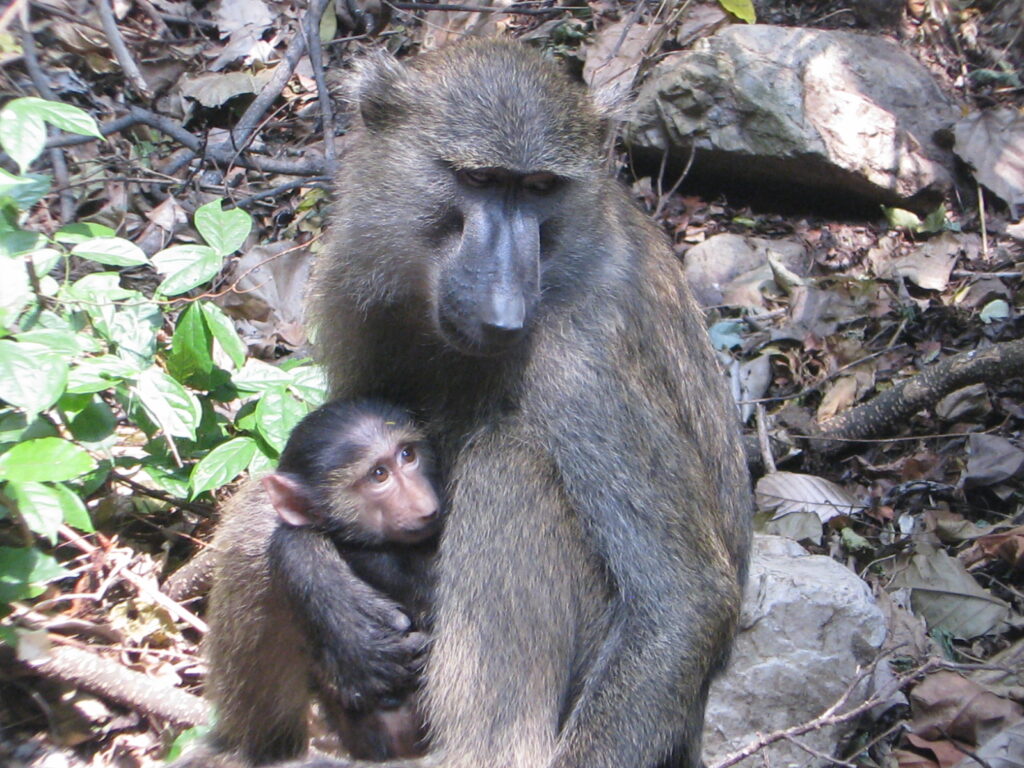

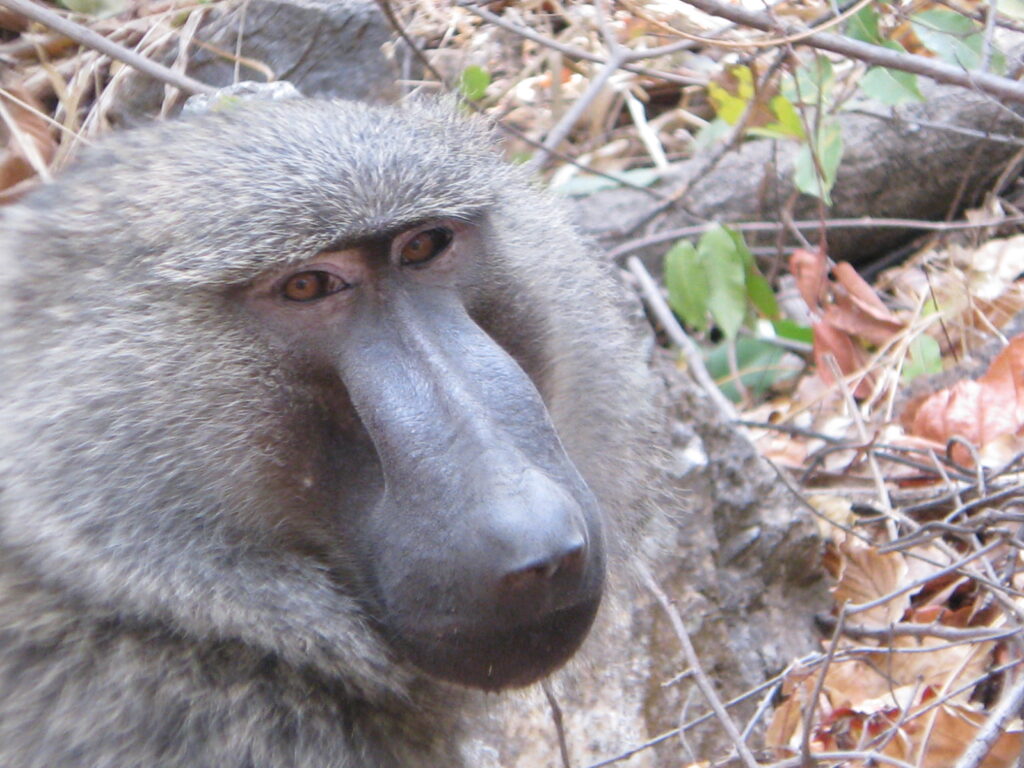
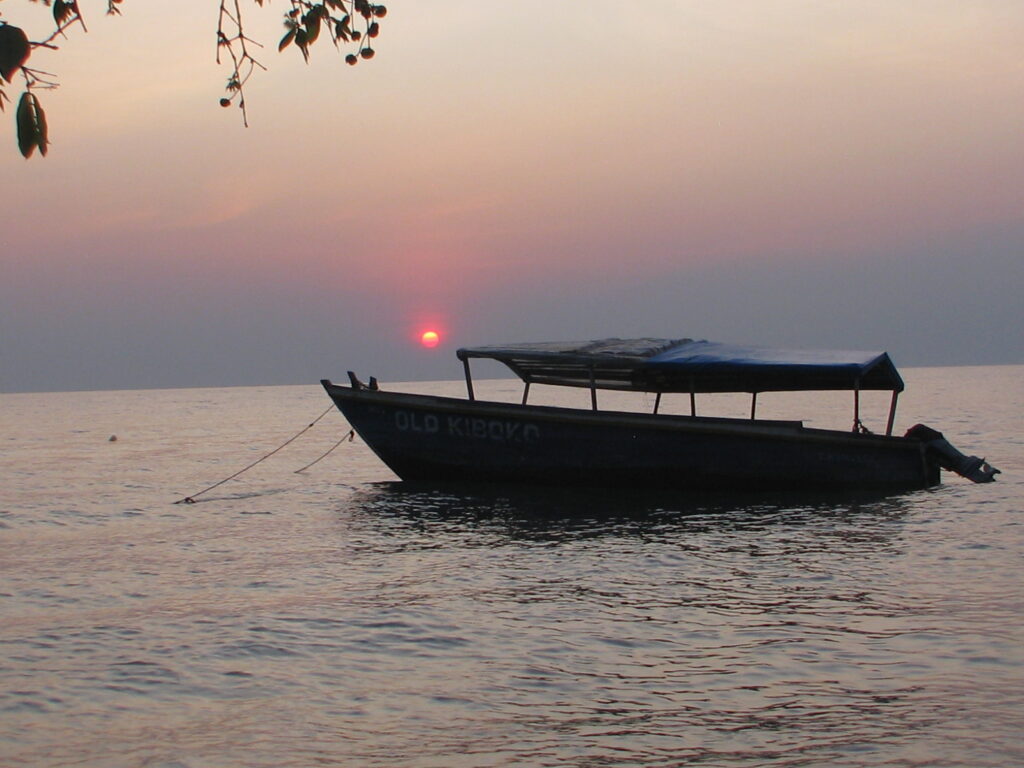

Is that some kind of termite nest in a tree?
Amazing chimp experiences! Wow. Sorry about the crowds though, but I guess that is the norm in most chimp and gorilla treks these days.
Re the “nest” you’ll just have to wait until the next post, as I don’t want to give it away for others. Re the chimps, yes, the first morning with Tanga’s family was crowded with 20-25 people, but the next day with the long trek and 7 chimps was just 3 of us and then 6 of us, so it was actually pretty nice. Cheers and see you soon!
African termite, arboreal kind?
Good guess, but you will have to wait until next post to see if you are right! Cheers.
Very cool. Too bad you missed meeting Jane Goodall by only a few days! Watching your videos and having seen Mountain gorillas in Uganda, it always raised the question in my mind of where one would draw the line on sentience. Clearly these primates are sentient. Lions? Warthogs? Lilac-breasted rollers? Crocodiles? Carp? Leeches? Your thoughts?
Thanks again for sharing these stories, photos and videos. What an amazing adventure!
What a good question and not an easy one to answer. Even if we said sentience involved understanding ones place in the universe, or having empathy for your fellow beings, or the more classical idea that it involves having feelings, how would one ever prove any of these things. It is quite clear that all the primates I have observed, especially the chimps, have very strong emotions and understand their position in their social network, and I expect that all animals have varying degrees of this. So its not whether they have it or not, but rather the degree; it’s a continuum as you might expect. So we or at least I really couldn’t draw a line for being sentient or not, since it is not binary. Anyways, I don’t think sentience should even be a consideration for how we treat animals as all are equally deserving; of course, this reflects my biocentric view of the world which is in contrast to what many religions preach about the preeminence of humans, which I find to be complete nonsense. That’s a few of my thoughts. Cheers.
Thanks Kevin! I completely agree.
Enjoyed watching the baby chimp’s antics, never far from mama.
Is the mystery pic of a wasps nest? Looks like a giant mud dauber.
That’s a very good guess, but you will have to wait until next post to see if you are right! Cheers.
I was going to go with termite nest, but since Mark went with that I’ll go with killer bees
That’s another good guess, but you will have to wait until next post to see! Cheers.
I agree with a species of the wasp. loved the video, pictures and informative blog. Looking forward to hearing from you in a couple of days.
OK, that’s a good guess, but you’ll have to wait until my next post to find out. Love ya.
Great narrative. Love the chimps. On mud “thing” I’ll also go with termite. Did not realize Lake Tanganyika was quite that large and deep.
That’s a good guess. Perhaps by the time you read this reply you will have already read my next post and seen the answer – arboral nesting ants. Very close to termites. Yes, Tanganyika is huge, AND it is like 3,000-4,000 ft deep at its deepest, hence the huge volume. Cheers.